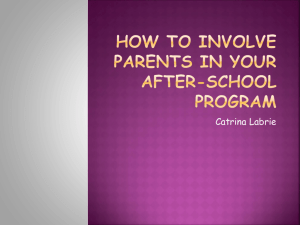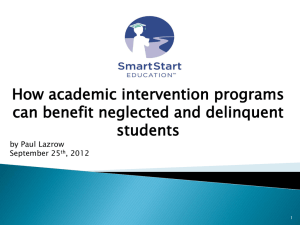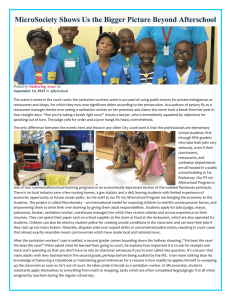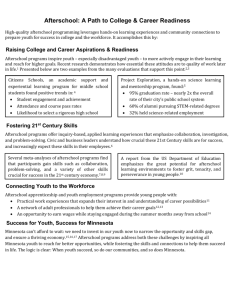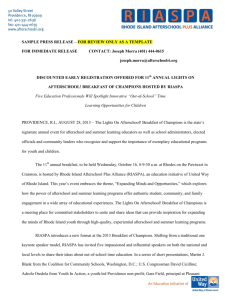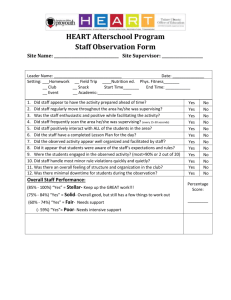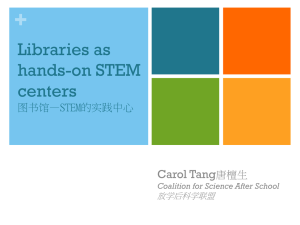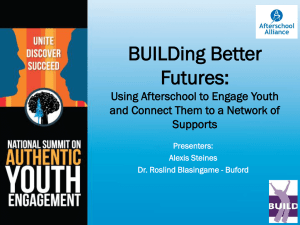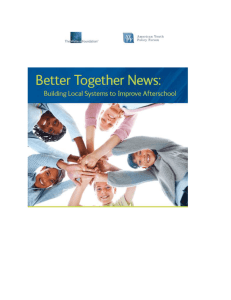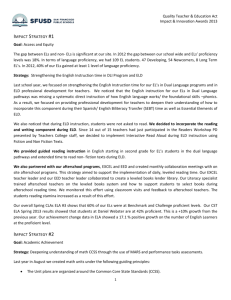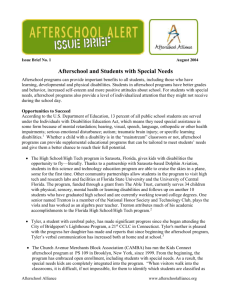SCHOOL AGE: Curriculum Statement Template
advertisement
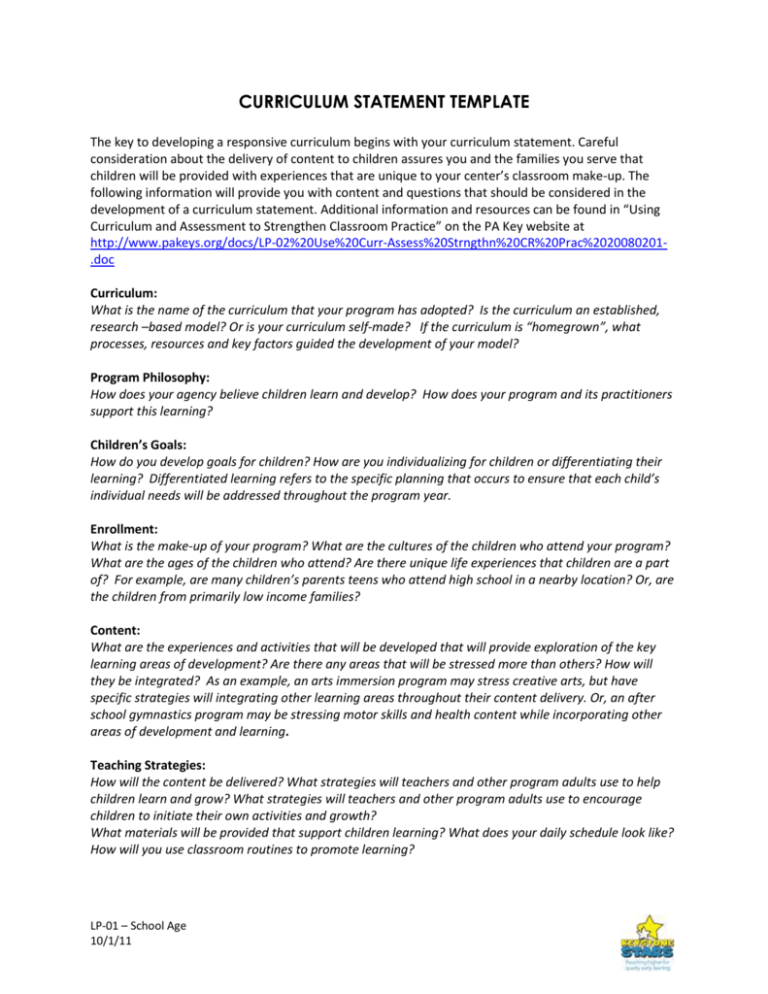
CURRICULUM STATEMENT TEMPLATE The key to developing a responsive curriculum begins with your curriculum statement. Careful consideration about the delivery of content to children assures you and the families you serve that children will be provided with experiences that are unique to your center’s classroom make-up. The following information will provide you with content and questions that should be considered in the development of a curriculum statement. Additional information and resources can be found in “Using Curriculum and Assessment to Strengthen Classroom Practice” on the PA Key website at http://www.pakeys.org/docs/LP-02%20Use%20Curr-Assess%20Strngthn%20CR%20Prac%2020080201.doc Curriculum: What is the name of the curriculum that your program has adopted? Is the curriculum an established, research –based model? Or is your curriculum self-made? If the curriculum is “homegrown”, what processes, resources and key factors guided the development of your model? Program Philosophy: How does your agency believe children learn and develop? How does your program and its practitioners support this learning? Children’s Goals: How do you develop goals for children? How are you individualizing for children or differentiating their learning? Differentiated learning refers to the specific planning that occurs to ensure that each child’s individual needs will be addressed throughout the program year. Enrollment: What is the make-up of your program? What are the cultures of the children who attend your program? What are the ages of the children who attend? Are there unique life experiences that children are a part of? For example, are many children’s parents teens who attend high school in a nearby location? Or, are the children from primarily low income families? Content: What are the experiences and activities that will be developed that will provide exploration of the key learning areas of development? Are there any areas that will be stressed more than others? How will they be integrated? As an example, an arts immersion program may stress creative arts, but have specific strategies will integrating other learning areas throughout their content delivery. Or, an after school gymnastics program may be stressing motor skills and health content while incorporating other areas of development and learning. Teaching Strategies: How will the content be delivered? What strategies will teachers and other program adults use to help children learn and grow? What strategies will teachers and other program adults use to encourage children to initiate their own activities and growth? What materials will be provided that support children learning? What does your daily schedule look like? How will you use classroom routines to promote learning? LP-01 – School Age 10/1/11 Environment: What is the design of your classroom and/or center environment? How does your program environment promote best practices in learning and development? How will your environments reflect the program philosophy, the cultural make-up of your center and the content that you’ve determined is important for children? Large group: What space and furniture arrangement will allow for large group activities including active play while allowing simultaneous individual play? Small group: What space and furniture arrangement will allow for children in work/play in small groups of their own choosing? Individual: How can supplies be arranged to encourage independent and creative use by children? Learning Standards: What strategies have you put in place to ensure the content is reflective of all the Key Learning Areas as written in the learning standards? Pennsylvania has learning standards for infants and toddlers, prekindergarten (ages 3-5), kindergarten, first and, second grade. For grades 3 and above teachers should use the Pennsylvania Academic Standards as a reference. Each classroom’s content should utilize the appropriate-aged standards for a responsive and well-designed curriculum. Resources: What curriculum tools or materials are you going to use to create strong classroom plans that are comprehensive in approach to reach all Pennsylvania’s Key Learning Areas, rich in experiences, and culturally, linguistically, and age appropriate? These resources can include published curriculum tools or locally designed (homemade) materials or a combination thereof. Professional Development: How will your agency support teachers’ ongoing learning so they can provide optimal learning experiences for the children you serve while enriching their background knowledge? Family Partnerships: What is your program philosophy for engaging families in program activities and children’s learning? How do you include families in developing goals or delivering the content? Community and School Partnerships: What are your program’s strategies for fostering community and school partnerships to support children’s learning? Assessment: What are your program’s strategies for assessing children’s knowledge and acquisition of skills? How does your assessment plan coordinate with the content you are teaching and the resources you are using? How is your program using portfolios to share assessments with students and parents? Inclusion: What strategies have you built to provide good learning opportunities for all children? How do you assure that all children are given rich experiences that are appropriate for their abilities and levels of development? LP-01 – School Age 10/1/11 Resource List: Afterschool Curriculum Frameworks and Guidelines Bickart, Toni S., Judy R. Jablon, and Diane Trister Dodge. 2005. Building the primary classroom: A complete guide to teaching and learning. Washington, D.C. and Portmouth, NH: Teaching Strategies, Inc, and Heinemann. Abstract: Comprehensive resource that puts the basic elements of classroom management and curriculum content together. This book addresses six strategies: 1) knowing the children you teach; 2) building a classroom community; 3) establishing a structure for the classroom; 4) guiding children’s learning; 5) assessing children’s learning; 6) building a partnership with parents. Curriculum content addressed include language and literacy, mathematical thinking, social studies, scientific thinking, technology, and the arts. Also addresses is social problem-solving, how children develop social-emotional skills and resiliency. The National Institute on Out-of-School Time. 2005. Links to Learning: A curriculum planning guide for afterschool programs. Nashville: TN: School-Age NOTES. Abstract: Provides after-school programs with tools needed to plan a well-balanced program, one that responds to the increasing call for academics in after school while addressing the full range of children’s developmental needs. Provides an overview of learning and child development; offers tips and tools for selecting, planning, developing and evaluating after-school activities; and demonstrates how to link these activities to sample learning and quality standards. Introduces the reader to curriculum resources focusing on seven “key learning areas” believed to be central to comprehensive, high-quality, after-school programs. YMCA of the USA. 2001. YMCA School-age care curriculum framework. Champaign, IL: National Council of Young Men's Christian Association of the United States of America. Abstract: While developed for YMCA programs addressing the mission and priorities of the YMCA this framework provides information about curriculum development useful to all school-age programs. It defines what a curriculum framework is and how it might be useful. It identifies how children's development and learning styles factor into curriculum development. This framework focuses on the eight content areas including Arts Humanities; Character Development; Health, Wellness and Fitness; Homework Support; Literacy; Science and Technology; Service-Learning; Social Competency and Conflict Resolution. Each content area address why it is important and what children can learn, provides suggestions about space needs, schedule, age appropriateness and suggested curriculum.. Additionally, this resource provides guidance on activity design, curriculum planning and implementation including staff development, documentation and evaluation, templates. Afterschool Curriculum Resources (Arts, Science, Math, Literacy, Technology) National Partnership for Quality Afterschool Learning. "Afterschool training toolkit: Building quality enrichment activities." Web page. Available at http://www.sedl.org/afterschool/toolkits/. Abstract: This website provides information on promising practices for implementing enrichment activities in your afterschool program. Content areas focus on the arts, literacy, math, science and technology. Video clips are provided of promising practices in action. Also provides links to national and state standards. Also included are methods for linking to other subject areas and linking with families and community. National Partnership for Quality Afterschool Learning. "Curriculum database." Web page. Available at http://www.sedl.org/afterschool/resources/curriculum.html. Abstract: This database is designed to help practitioners locate and make informed choices about highquality science, math, literacy and technology resources to enrich their programs. Resources were selected based on proven use in afterschool settings, and include challenging lesson plans and organized activities. Database provides a program description of each curriculum, cost, planning required, staff training and experience required to implement, whether the curriculum is research-based, aligned with LP-01 – School Age 10/1/11 national or state standards and evaluation methods. Professional Development Opportunities available through the Regional Keys Using Portfolios to Bring Out the Best in School-Age Children A six hour professional development event to support the successful implementation of Portfolios to support children’s development and enhance program quality. The session may be delivered as two, three- hour sessions titled: Part 1 of 2: - Supporting Children’s Development and Enhancing Program Quality; Part 2 of 2: - Preparing for Success Implementation of Portfolios. LP-01 – School Age 10/1/11 Keystone STARS Recognition Hrs Keystone STARS Standard 6 hrs Content will support Observation/Curriculum/Assessment at STAR 2, 3 and 4 for school-age practitioners and meet Staff Development requirement for this same content. Links to Learning (L2L) A series of 26 hours of professional development modules, developed by the National Institute on Out-of-School Time (NIOST), to support practitioner understanding of the role of afterschool in providing complementary supports to ensure developmental progress of children. Participants learn how to guide curriculum planning in afterschool and how to link activities to learning standards and quality standards. The content of the modules also explores theme- and project-based learning, coordinating and communicating with schools and family engagement. Following is a list of the modules: Core Series Requirement Theoretical Framework - Learning and Development * Curriculum Planning Basics (including Youth Engagement)* Linking Activities to Benchmarks and Standards* Theme- and Project-based Learning (including Youth Engagement)* Additional Support Professional Development Coordinating and Communicating with Schools Family Engagement Key Learning Area: Social and Emotional Learning Key Learning Area: Physical Activity and Healthy Learning Key Learning Area: Science Key Learning Area: Technology Key Learning Area: Arts Key Learning Area: Math Key Learning Area: Literacy Key Learning Area: Homework LP-01 – School Age 10/1/11 Keystone STARS Recognition Keystone STARS Standard Links to Learning Foundations* (4 modules, 6hrs.) meets STAR 2 Director Qualifications Core Series requirement for learning standards for school-age programs. Other modules meet STAR 3 annual Staff Development requirement in the area of curriculum and learning standards and supports Partnerships with Family and Community. Hrs 1.52hrs ea
